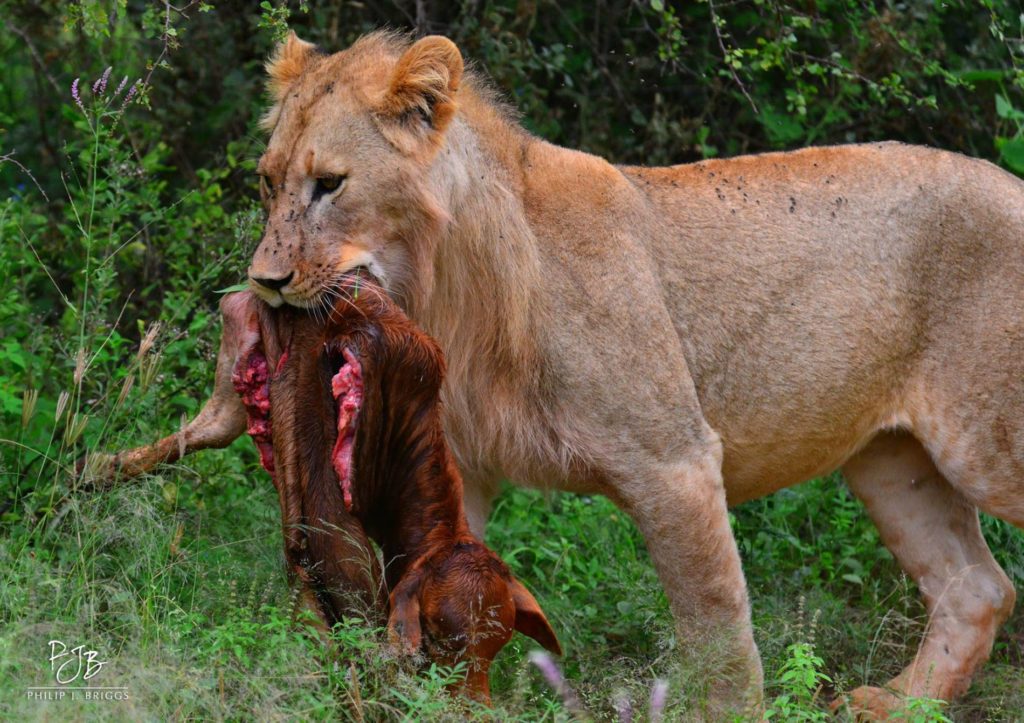Why “mock hunts” work

Mock hunts are an integral part of our conflict mitigation work. We are currently raising funds to triple the size of our conflict response team; to support this work, please visit our campaign page.
Many of our best conservation tools come from communities themselves, and “mock hunts” are no exception.
In the past, when a group of animals became bold and repeatedly threatened Maasai communities or their livelihoods, communities would hunt one of the animals – not with the intent to kill the entire group, but to scare the rest so they would stay away. Together, the Guardians and our monitoring team adapted this idea to encourage overly-bold lions to recognize humans (and their associated sounds and smells) as a threat they should avoid, rather than as a source of food.
Our mock hunts work like this: when a lion raids a boma, our team of traditionally-dressed Guardians follows the lion until they know where it is laying up for the day. Without letting the lion detect their presence, they move in, making traditional Maasai hunting whoops and throwing loud fireworks. The lion is jolted awake and scared by the sudden sounds, and it bolts and runs as fast as it can to a thicker area where it can hide; sometimes, lions will run more than five kilometers! Our team pursues the lion until it is out of harm’s way in an area that has enough wild prey to sustain it. The goal, of course, is not to hurt the lion (the team makes no physical contact whatsoever), but to chase it away and deter it from attacking bomas in the future.

Our Director of Science Stephanie Dolrenry has a memorable way to explain the technique: “I think of it like training a puppy not to pee in the house. The goal is to catch the dog in the act and then whack a rolled-up newspaper loudly against a table or wall so the loud noise scares them, and then to show them outside, where they should be peeing.” Another good analogy is what’s called “conditioned aversion”: if you eat something that makes you sick, you may never want to eat it again…even the sight or smell of it can make you nauseous! Experiencing a mock hunt can deter lions in a similar way.
For instance, a lion was repeatedly raiding bomas in an area called Eselenkei, and we eventually identified the lion as a sub-adult male named Koyiombo. We mock hunted him right after his next boma attack, scaring him enough to stop his livestock-killing habits. We find that for young, dispersing lions like Koyiombo who are recently independent of their pride, this negative experience and subsequent aversion to people, loud noises, and livestock has a dramatic effect – they may never go back to boma-raiding.

It doesn’t always work as well with older lions who have been raiding bomas for many years; you’ve probably heard the saying “you can’t teach an old dog new tricks.” But even so, mock hunts do delay these lions’ returns to bomas, which gives communities respite and a few nights of good sleep, helping cool tensions.
We’re excited that mock hunts are an effective deterrent, and we’re proud that we have worked with Guardians and Maasai communities to develop this cuturally-based conservation tool. We’re currently collecting data to better understand when, where, and why mock hunts are effective, and we look forward to sharing more of this work in the future!
You can read more about mock hunts in this article at Ensia.



Leave a Reply